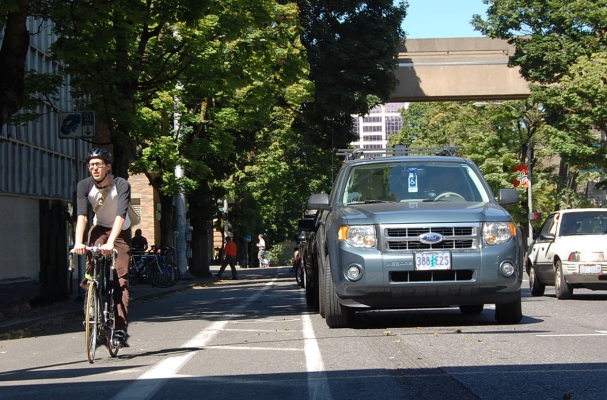Report: Barriers, distance from cars clear air for cyclists

Moving cyclists just a few feet from automobiles can make a big improvement in air quality, an OTREC research project found. That’s the distance between a traditional bike lane and a separated cycle track.
Researcher Linda George, the chair of Portland State University’s Environmental Science and Management Department, looked at Portland’s Broadway cycle track as part of a study on urban air quality. Download the final report. Specifically, George’s team examined the microscopic particles, called ultrafine particles (UFP), given off by automobile engines.
Those tiny particles can get deep into lungs and other tissues and contribute to a host of ailments. Cyclists are doubly at risk: they bike through some of the highest concentrations of UFP while their exertion causes them to breathe more heavily, introducing more of the particles into their systems.
George and her team, which included Portland State associate professors Miguel Figliozzi and Chris Monsere, looked at whether distance and barriers affect the amount of UFP that cyclists encounter. Portland’s Broadway cycle track offered a perfect study setting. In 2009, the Portland Bureau of Transportation created a dedicated cycle path by moving parking away from the curb, using parked cars to separate bicycle and automobile traffic.
The research team took air-quality measurements using sensitive particle counters that draw in air cyclists would be breathing. Researchers created a new technique to compare the particle levels of both a bike lane and the cycle track at the same time: they parked a car in the parking lane and rigged a particle counter to each side-view mirror. The driver’s side measured air quality immediately adjacent to the right-side automobile lane, where a traditional bike lane would be. The passenger side sampled air near the actual cycle track.
The results showed the cycle-track side with significantly lower UFP levels: 8 to 38 percent lower than the bike-lane side. “That was a surprise,” George said, “given the very short distance between the two.
“You’re looking at only the distance of a car width between the two positions,” she said.
In that small distance, the sticky particles coagulate into larger particles and are diluted as they get farther from the tailpipe. The line of parked cars bordering the cycle track also affects the airflow, George said. “The other thing going on is, because of the presence of cars, there’s a barrier effect.” That the barrier effect can be obtained without building any permanent structure also helps keep the cost of creating a cycle track low.
This project demonstrates one more benefit of cycle tracks, said Monsere, who evaluated the Broadway cycle track in an earlier study. "This shows that there’s another reason, besides safety and convenience, why you might want to have that separation between bikes and other vehicles."
Separately, the project considered bicycle paths near freeway noise barriers. While designed to keep sound down in adjacent neighborhoods, the barriers also affect the UFP levels cyclists breathe. The research team found that paths on the shielded side of the barrier had significantly lower levels than those on the exposed side.
“We would recommend, if you have a choice where to put a bike lane in relation to a sound wall, you should put it behind the sound wall,” George said. While intuitive, that conclusion hadn’t received much attention before, she said. “I don’t think anyone really thought of that before.”
Indeed, it took some serendipity to focus the researchers on sound walls to begin with. While waiting for equipment to take traffic counts along Interstate 205, researchers just started making air-quality measurements. The equipment never arrived, but the team had something better. “Good science comes out of bad luck,” George said.
Learn more about the project and download the final report here.
